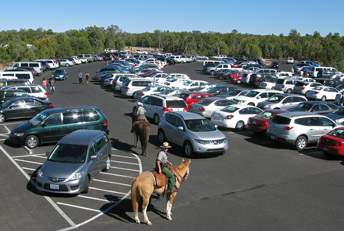National parks: window on America
The Reagan years and their aftermath
The period of plenty ended with the Reagan administration. Michael Kellett, director of the New National Parks Project, an organization devoted to encouraging the creation of new national parks, says that the Reagan years were dark ones for NPS — and that the legacy of those years still reverberates today. “The main problem with our existing parks is that NPS has been starved in terms of budget and morale [ever] since Reagan [when it was] battered and abused.”
“When James Watt came along [as Secretary of the Interior], he cut the budget and put on caps, basically told the Parks Service, ‘We don’t want to hear from you about expanding parks; it’s the business of Congress,’” says Kellett, adding that, since that time, “A lot of people with vision have left the National Parks,” and the technological capacity, “has been gutted.”
A vast system — but how healthy?
Today, the Park Service includes 394 park units — which range from national historic sites like the home of Franklin Delano Roosevelt to recreational areas like the Delaware Water Gap National Recreation Center to the large and scenic parks like Acadia and the Grand Canyon that are most frequently associated with the National Park Service.
Park Service Artifacts
The inventory of the national parks includes everything from early Native American clothing to famous paintings and sculptures to the clothes that Lincoln was wearing when he was assassinated.
Some experts, like James Nations of NPCA, say that the NPS needs better storage facilities.
According to the National Parks Conservation Association (NPCA) the park service includes 7,600 public and administrative buildings, 680 water and waste systems, 12,000 miles of paved and unpaved roads, 26,000 historical structures, and more than 121 million museum specimens and artifacts. In fact, the Park Service oversees more artifacts than any other federal agency — even the Smithsonian.
Some indicators might lead to an optimistic prognosis for the parks: park visiting rates are high, and current funding is 10 percent higher than in the last year of the George W. Bush administration. In anticipation of the centennial of the parks in 2016, NPS Director John Jarvis has proposed a Call to Action for a Second Century of Stewardship, a report that outlines a strategy for the parks, emphasizing outreach to the American public, education, preservation, and innovation.
But status reports from park advocates are mixed. Richard B. Smith, a member of the executive council of the Coalition of National Park Service Retirees, says that the parks “are in remarkably good shape” for the number of visitors that they get. “But,” he adds, “It’s getting tougher and tougher,” to maintain them.
In recent years, some parks have been criticized for overcrowding. But while Smith suggests that the problem of overcrowding may be overstated — “Once you get off the road,” he says, “unless you walk the most popular trail in the world, you’re going to be alone” — he does point out that the enormous growth of the population of the United States since the founding of the large parks has created a difficult challenge. Whereas there were approximately 500 visits to Yellowstone in the first year of the Parks System, Smith says, Yellowstone now hosts 3 million visitors a year. He notes with some understatement, “Conditions have changed.”
Conditions have changed in other ways as well. The parks are subject to invasive species, failing sewage systems, underfunding, and a deferred maintenance backlog of almost $9 billion. “The park service will never catch up,” says Pitcaithely. “And we’ll never know going into the park, because they keep the front part looking nice, painted and paved and all that, but you start noticing around the back part…that things are not as well kept [up].”
Experts, however, say that most people aren’t aware of these shortcomings because the park service does a good job of concealing them. “Visitors are largely satisfied with their visit, because the park service is incredibly good at robbing Peter to pay Paul,” says Picaithely.
“Cutting ribbon at a new visitor center is a great political theater,” Barna says, but there is less support for “repairing the sewage system at Yellowstone that badly needs [it].”
Every year, the park service experiences an operations shortfall of nearly $600 million. “They’re not the way they were in the beginning,” says James Nations, director of the Center for National Park Research, a branch of NPCA. “We’ve lost species in 90 percent of the parks, air quality is sub-standard, [and] we’re losing cultural resources because we don’t even have a good inventory of what we have.” Smith says that the parks are seriously understaffed: “Many parks have huge numbers of vacant positions that they can’t fill [due to budget constraints]. When you don’t have the people, you can’t do the job. We’re no longer cutting fat; we’re cutting muscle and bone.”
Pitcaithely agrees. Asked what the Park Service needs for improvement, he answers, “We need more historians, more interpreters, archaeologists, biologists to maintain the intellectual integrity of the agency.” He would also like to see exhibits updated. Their average age is currently 20 years, but some are as old as 50.

